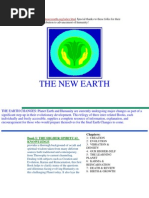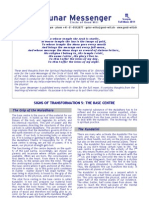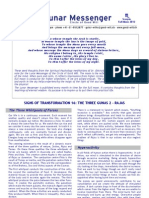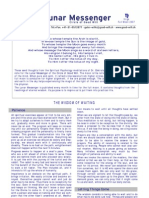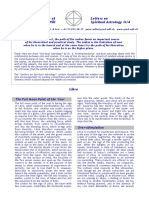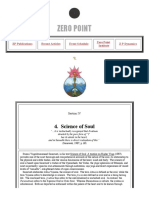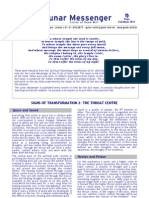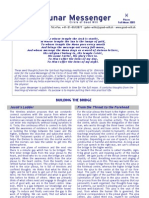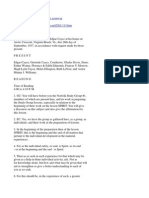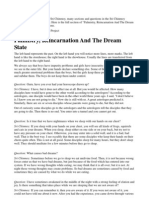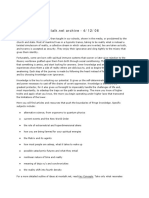E Lunar2 10
E Lunar2 10
Uploaded by
Stefaan Van NuffelCopyright:
Available Formats
E Lunar2 10
E Lunar2 10
Uploaded by
Stefaan Van NuffelOriginal Title
Copyright
Available Formats
Share this document
Did you find this document useful?
Is this content inappropriate?
Copyright:
Available Formats
E Lunar2 10
E Lunar2 10
Uploaded by
Stefaan Van NuffelCopyright:
Available Formats
_
Taurus Full Moon 2006
To whose temple the Arch is starlit, In whose temple the Sun is the image of gold, To whose temple the Moon goes every month And brings the message out every full-moon, And whose message the Moon sings as a word of sixteen letters, His religion I belong to, His temple I visit, His name I utter, His glory I live in. To Him I offer the lotus of my day, To Him I offer the lotus of my night. These seed thoughts from the Spiritual Psychology meditations of Dr. Ekkirala Krishnamacharya give the note for the Lunar Messenger of the Circle of Good Will. The moon is the reflective principle and symbol of the mind. When pure and calm, it reflects impressions from higher circles. Especially the time of the full moon is conducive for higher alignment, if we are poised enough. The alignment of the sun, moon and earth in the sky helps experiencing the magic of the light of the soul and its manifestation down to the physical. The Lunar Messenger is published every month in time for the full moon. It contains thoughts from the teachings of eternal wisdom. Its purpose is to inspire putting them into practical life.
THE BUDDHIC PLANE
Intellect and Intuition
The intellectual abilities of man encompass analytical thinking and interpreting. This is reinforced through today s educational system and is important in order to be effective in the external world. The development of the intellect should not be confused with spiritual development though. One of the spiritual abilities is the power of synthesis, through which we recognize the deeper correlations and the meaning of that which leads us to intellectual understanding. The intellect thinks critically. Wisdom sees everything according to its purpose, and unanimity dominates. The apparent contrasts complement each other, said Pythagoras. The intellect or mind can be equated with the Manasprinciple, spirituality with Buddhi or the light of wisdom, and highest Divinity with Atma. While Manas transmits messages from the environment to the inner man and also carries commands of will from within to the outside, Buddhi makes decisions about how to do things the right way. It knows what is good and bad, what we should do or what rather not. In terms of reasoning, there is a gap between what we know and what we do. We must build a bridge over this gap in order to live our lives in the light of wisdom. The bridge spans from the mental to the Buddhic plane, from intellect to intuition. In the beginning, intuition is only a flashlight; but over time it transforms into a daily occurrence. You connect yourselves, thus you receive. This is the promise of every master. I guide and teach you from within. I will organize your personality from within. I will conduct the necessary transformations.
Guidance from Within
Many people do not dare to meditate on the Buddhic plane. In this case, we choose a master who lives there, a Master of Wisdom. He is always on the Buddhic plane, and by meditating upon him we are already there ourselves - without knowing it. The daily contemplation is important to re-call him in ourselves. When we close our eyes, we visualize the shape we are invoking as beautiful and as full of light as we can, and we connect mentally with it. We can talk to him and tell him our problems. We can ask for guidance and advise. Then, the Buddhic plane will unfold in us, and we will hear in the heart what we should plan and do. Without a teacher, we can easily get lost on the mental or Buddhic plane and become stuck. There is even a certain part of the Buddhic plane where twisting and manipulation can occur. This way, some religions distorted old wisdom concepts and claimed them their properties to gain advantage. For most people wisdom remains a concept as it appears in the books they study. It is only a mental burden for them without any real purpose. When some talk about wisdom, we feel like running away because all they do is recalling conceptual ideas. They have neither assimilated what they studied, nor have they experienced the wisdom. The purpose of studying wisdom is to step forward to the Atmic plane and to enter into self-awareness which we call the I AM or the soul. There, wisdom disappears, just as the mental concepts have disappeared before hand already. Everything disappears - only the beauty of the awareness of existence remains.
The reasoning capacity of an elephant does not fit into that of a fly. Buddhi, the capacity of the soul, is much greater than the capacity of the brain. Thus, it resides outside of the brain rather than within. The brain is only an instrument of the soul and, hence, the reasoning capacity of it. The initiate does not think with the brain, but outside of it. That is why many initiates are proclaimed insane by their fellow men who cannot understand them. The one, for example, who lives in the higher realms of the Buddhic plane does not consider anything to belong to him, while the average man constantly thinks in terms of mine and yours . For the initiate, it is an experience that everything belongs to the One, even he himself. He does not think my possession, my house, my land When he contemplates upon the soul, he forgets his body. The idea of holding on to something belongs to the reasoning capacity and the lower levels of Buddhi.
Colors
Orange is the color of light in the material, the spirit in matter. Golden-yellow is the color of the light of the pure Buddhic plane, the most subtle material, also called Devachan. Blue is the color of the spiritual plane, beyond matter. When we elevate ourselves to the Buddhic plane, we can perceive colors clearly and even hear their sounds. One symbol for contemplation is a blue center surrounded by golden-yellow which is framed by orange. If we see ourselves as spirit at the center of a circle, then the first circle around the center is the light, the soul itself; its enlightenment is called Buddhi. We don t have to do anything to purify this light. Then there is the personality. Depending on how advanced we are, it is controlled by either higher or lower thinking. The mind needs to be cleared of impurities to a point where thinking becomes transparent. The light of the soul can shine through the body when thoughts are no longer drenched with personal motives and desires.
Buddhic Planes
When we divide the Buddhic planes into three parts, we find all wisdom books on the third and lowest part. The books are accessible by our mind; there is a certain logic in them and many explanations. When we ascend to the second and first level of the Buddhic plane, we find intuition in the second part and pure experience in the first. Intuition does not stand logic. We may develop a certain logic for intuition, but when it comes to experience things become more difficult. Oftentimes, in occult sciences such as astrology the act of interpretation derives from the intuitive plane; something make sense, although there is no logical explanation regarding the constellation of the planets. This is a common experience for those who work with astrology and homeopathy from the intuitive plane. The mental body, too, we can divide into three parts: in the mental-emotional, the coloring of the mental lies somewhere between orange and pink. On the higher planes, the emotional aspect of the mental transforms into the love of wisdom. The intellectual-mental is filled with a bright orange color when the thinking is not crystallized, but clear and flexible. The orange color of the pure mental enables us to experience wisdom. Wisdom is experienced as golden-yellow and leads eventually to a honey-yellow color. The intuitive-mental is the body of intuition; also called the Buddhic body, which is of a bluish-white light. The motivate force of the body of wisdom is called causal body.
Calling down the Light
This, we want to accomplish through spiritual practice such as the daily singing of Gayatri. The true essence of Gayatri is the alignment with the Buddhic plane. We ask for a stimulation of the Buddhic plane in us so that the light can descend and rule over our thinking. Tat Savitur Varenyam may the light embrace us. We meditate upon the source of all light, Bhargo Devasya Dhimahi , so that the light of the soul can descend: Dhiyo Yonah Prachodayat . And in the Great Invocation, we say, From the Point of Light within the Mind of God - Let Light stream forth into the minds of men - Let Light descend on Earth. We can visualize how the light radiates from the head center, from the jewel in the lotus, and penetrates us from the Ajna center: OM MANI PADME HUM . Buddha gave it so. Hum is like OM a sound of invocation. The light should penetrate us to that extent that our personality is freed of all egotism and we recognize the soul in everything. We should contemplate upon this daily when we fill our system with the energy of the soul. All those who continually stand in the light of the soul on the Buddhic plane are called Buddhas or Masters of Wisdom. Especially during the Vaisakh full moon, the full moon of the Buddha, we can open ourselves to receive the energies of the Buddhic plane.
Sources used: K.P. Kumar: Mithila / seminar notes E. Krishnamacharya: Occult Anatomy / Full Moon Meditations. The World Teacher Trust - Dhanishta, Visakhapatnam, India (www.worldteachertrust.org )
Good Will is contagious !
The Lunar Messenger is published in English, French, German, and Spanish. On request we will include you in our mailing list: guter-wille@good-will.ch . Further information on www.good-will.ch . If you do not want to receive the Lunar Messenger anymore, please notify us briefly. Circle of Good Will
You might also like
- Christian Andreason - Walking in The Garden of A Loving GodDocument122 pagesChristian Andreason - Walking in The Garden of A Loving GodludovladeNo ratings yet
- Chapter 7 - "The Living Soul"Document94 pagesChapter 7 - "The Living Soul"SomeKindaSayRah100% (1)
- Kundalini Awakening: Home Cds Schools Tantra Shakti Yoga/Vedanta/Tantra Yoga SutrasDocument5 pagesKundalini Awakening: Home Cds Schools Tantra Shakti Yoga/Vedanta/Tantra Yoga SutrassanniviNo ratings yet
- The New EarthDocument198 pagesThe New EarthJedidah67% (6)
- Indigo and Crystal ChildrenDocument9 pagesIndigo and Crystal ChildrenDavi Sadaseeven SaminadenNo ratings yet
- 435 - 2010 - The New Gods and The Exploration of The Nightside PDFDocument118 pages435 - 2010 - The New Gods and The Exploration of The Nightside PDFAndrej KapcarNo ratings yet
- Signs of Transformation 5: The Base CentreDocument2 pagesSigns of Transformation 5: The Base CentreStefaan Van NuffelNo ratings yet
- Impulse and Impulsivity: Stimulation of KarmaDocument2 pagesImpulse and Impulsivity: Stimulation of KarmaStefaan Van NuffelNo ratings yet
- Dissolution and Creation: Eternal ExistenceDocument2 pagesDissolution and Creation: Eternal ExistenceStefaan Van NuffelNo ratings yet
- The Secret of The Dawn: Darkness and Light of ExistenceDocument2 pagesThe Secret of The Dawn: Darkness and Light of ExistenceStefaan Van NuffelNo ratings yet
- E Lunar9 4Document2 pagesE Lunar9 4Stefaan Van NuffelNo ratings yet
- E Lunar6 11Document2 pagesE Lunar6 11Stefaan Van NuffelNo ratings yet
- E Astro Taurus 3Document2 pagesE Astro Taurus 3Charles LeMageNo ratings yet
- The Kundalini: The Inner Power of NatureDocument2 pagesThe Kundalini: The Inner Power of NatureStefaan Van NuffelNo ratings yet
- The Work of The Moon 3: The Magic of The MoonDocument2 pagesThe Work of The Moon 3: The Magic of The MoonStefaan Van NuffelNo ratings yet
- Signs of Transformation 8: The Head CentreDocument2 pagesSigns of Transformation 8: The Head CentreStefaan Van NuffelNo ratings yet
- E Lunar9 3Document2 pagesE Lunar9 3Stefaan Van NuffelNo ratings yet
- Aquarian Wind 1: Crises: Fiery TransformationsDocument2 pagesAquarian Wind 1: Crises: Fiery TransformationsStefaan Van NuffelNo ratings yet
- Aquarian Wind 8: Etheric ExistenceDocument2 pagesAquarian Wind 8: Etheric ExistenceStefaan Van Nuffel100% (2)
- 12 FS Course 2.1bDocument3 pages12 FS Course 2.1babnerzarkaNo ratings yet
- DharmaDocument28 pagesDharmaphani1978No ratings yet
- The Work of The Moon 1: New Moon: Visibility and InvisibilityDocument2 pagesThe Work of The Moon 1: New Moon: Visibility and InvisibilityStefaan Van NuffelNo ratings yet
- Cooperating With The Devas: Intelligences in NatureDocument2 pagesCooperating With The Devas: Intelligences in NatureStefaan Van NuffelNo ratings yet
- The Wisdom of Waiting: PatienceDocument2 pagesThe Wisdom of Waiting: PatienceStefaan Van NuffelNo ratings yet
- BombinaDocument3 pagesBombinamaxNo ratings yet
- E Lunar7 10Document2 pagesE Lunar7 10Stefaan Van NuffelNo ratings yet
- Number Seven: Numbers - Potencies of NatureDocument2 pagesNumber Seven: Numbers - Potencies of NatureStefaan Van NuffelNo ratings yet
- Fatal Sin!Document14 pagesFatal Sin!Vr-oneNo ratings yet
- Signs of Transformation 14: The Element of AkashaDocument2 pagesSigns of Transformation 14: The Element of AkashaStefaan Van NuffelNo ratings yet
- Astrology Numerology &: We All Share An Intimate RelationshipDocument2 pagesAstrology Numerology &: We All Share An Intimate Relationshipshubham_mondal9744No ratings yet
- The Mysteries of Sumerian CultsDocument6 pagesThe Mysteries of Sumerian CultsFrederic LefrancoisNo ratings yet
- Circle of Letters On Good Will Spiritual Astrology d/4: The Full Moon Point of The YearDocument2 pagesCircle of Letters On Good Will Spiritual Astrology d/4: The Full Moon Point of The YearCharles LeMageNo ratings yet
- Faruk Dilaver - Divine LoveDocument25 pagesFaruk Dilaver - Divine LoveFarukDilaverNo ratings yet
- Triple TransformationDocument81 pagesTriple TransformationIan JamesNo ratings yet
- Aquarian Wind 6: Sushumna: The NadisDocument2 pagesAquarian Wind 6: Sushumna: The NadisStefaan Van NuffelNo ratings yet
- Twin Souls AurobindoDocument5 pagesTwin Souls AurobindoRayBoyd100% (1)
- Nature and Living Naturally: The Mother of The WorldDocument2 pagesNature and Living Naturally: The Mother of The WorldStefaan Van NuffelNo ratings yet
- Avatars and GurusDocument6 pagesAvatars and Gurussantmat_oregonmedNo ratings yet
- Sahasrar Chakra and Brahmarandhra Centers of Divine PowersDocument10 pagesSahasrar Chakra and Brahmarandhra Centers of Divine PowersCandice MorrisseyNo ratings yet
- The Angelic Hosts by Geoffrey HodsonDocument35 pagesThe Angelic Hosts by Geoffrey HodsonLong JohnsonNo ratings yet
- The Living Name: A Guide To Chanting With AbsorptionDocument3 pagesThe Living Name: A Guide To Chanting With AbsorptionRadharani rasasNo ratings yet
- Yearning of The SoulDocument97 pagesYearning of The SoulViraj PanaraNo ratings yet
- The Physics of The Day of JudgementDocument15 pagesThe Physics of The Day of JudgementnisryneNo ratings yet
- E Lunar5 7Document2 pagesE Lunar5 7Stefaan Van NuffelNo ratings yet
- Science of Soul - Heart DoctrineDocument4 pagesScience of Soul - Heart DoctrineMarinela TacheNo ratings yet
- Lord Siva MahasivaratriDocument7 pagesLord Siva MahasivaratriSudhanshu GoswamiNo ratings yet
- Barak AllahDocument11 pagesBarak AllahRicko Dwi Adi SaputraNo ratings yet
- E Astro AriesDocument2 pagesE Astro AriesCharles LeMageNo ratings yet
- Karma, DNA of Our Soul: Read Complete Article BelowDocument6 pagesKarma, DNA of Our Soul: Read Complete Article BelowddhilipkumarNo ratings yet
- Atma Gnan (Soul Zodiac, Grahas) - Western VariousDocument21 pagesAtma Gnan (Soul Zodiac, Grahas) - Western VariousSuresh SrinivasanNo ratings yet
- E Lunar7 11Document2 pagesE Lunar7 11Stefaan Van NuffelNo ratings yet
- Animal Symbolism - toteMS.dream Analysis..a To ZDocument71 pagesAnimal Symbolism - toteMS.dream Analysis..a To Zbj ceszarNo ratings yet
- Human Brain Apparent Boon of OmnipotentDocument103 pagesHuman Brain Apparent Boon of OmnipotentChandan MundhraNo ratings yet
- ANGELSDocument9 pagesANGELSEsther HernandezNo ratings yet
- Circle of Letters On Good Will Spiritual Astrology f/2: The Astrological Key The Single-Minded SagittarianDocument2 pagesCircle of Letters On Good Will Spiritual Astrology f/2: The Astrological Key The Single-Minded SagittarianCharles LeMageNo ratings yet
- Hacker-Dharma in HinduismDocument18 pagesHacker-Dharma in HinduismAnandaNo ratings yet
- Chakras and Lotuses: Etheric Whirlpools of ForceDocument2 pagesChakras and Lotuses: Etheric Whirlpools of ForceStefaan Van Nuffel100% (1)
- The Hierarchy of Archangel Haniel or Anael: Anjos da Cabala, #19From EverandThe Hierarchy of Archangel Haniel or Anael: Anjos da Cabala, #19No ratings yet
- The Out-of-Body Travel Foundation Journal: My Out-of-Body Journey with Shirdi Sai Baba, Hindu Avatar - Issue TwoFrom EverandThe Out-of-Body Travel Foundation Journal: My Out-of-Body Journey with Shirdi Sai Baba, Hindu Avatar - Issue TwoRating: 5 out of 5 stars5/5 (1)
- Signs of Transformation 14: The Element of AkashaDocument2 pagesSigns of Transformation 14: The Element of AkashaStefaan Van NuffelNo ratings yet
- Signs of Transformation 4: The Sacral CentreDocument2 pagesSigns of Transformation 4: The Sacral CentreStefaan Van NuffelNo ratings yet
- E Lunar9 1Document2 pagesE Lunar9 1Stefaan Van NuffelNo ratings yet
- The Seven Races: Our Own HistoryDocument2 pagesThe Seven Races: Our Own HistoryStefaan Van NuffelNo ratings yet
- E Lunar9 3Document2 pagesE Lunar9 3Stefaan Van NuffelNo ratings yet
- Signs of Transformation 9: The 5 ElementsDocument2 pagesSigns of Transformation 9: The 5 ElementsStefaan Van NuffelNo ratings yet
- Signs of Transformation 8: The Head CentreDocument2 pagesSigns of Transformation 8: The Head CentreStefaan Van NuffelNo ratings yet
- E Lunar8 11Document2 pagesE Lunar8 11Stefaan Van NuffelNo ratings yet
- Signs of Transformation 10: The Element of EarthDocument2 pagesSigns of Transformation 10: The Element of EarthStefaan Van NuffelNo ratings yet
- E Lunar7 11Document2 pagesE Lunar7 11Stefaan Van NuffelNo ratings yet
- Signs of Transformation 6: The Higher Heart CentreDocument2 pagesSigns of Transformation 6: The Higher Heart CentreStefaan Van NuffelNo ratings yet
- E Lunar8 2Document2 pagesE Lunar8 2Stefaan Van NuffelNo ratings yet
- Building The Bridge: Jacob S Ladder From The Throat To The ForeheadDocument2 pagesBuilding The Bridge: Jacob S Ladder From The Throat To The ForeheadStefaan Van NuffelNo ratings yet
- Aquarian Wind 9: Expansion: Horizontal and Vertical ExpansionDocument2 pagesAquarian Wind 9: Expansion: Horizontal and Vertical ExpansionStefaan Van NuffelNo ratings yet
- E Lunar7 13Document2 pagesE Lunar7 13Stefaan Van NuffelNo ratings yet
- Aquarian Wind 6: Sushumna: The NadisDocument2 pagesAquarian Wind 6: Sushumna: The NadisStefaan Van NuffelNo ratings yet
- E Lunar7 12Document2 pagesE Lunar7 12Stefaan Van NuffelNo ratings yet
- Aquarian Wind 4: Manifesting: Manifestation of MatterDocument2 pagesAquarian Wind 4: Manifesting: Manifestation of MatterStefaan Van NuffelNo ratings yet
- Aquarian Wind 8: Etheric ExistenceDocument2 pagesAquarian Wind 8: Etheric ExistenceStefaan Van Nuffel100% (2)
- E Lunar7 10Document2 pagesE Lunar7 10Stefaan Van NuffelNo ratings yet
- Meditation For The Aquarian Age: Our Original IdentityDocument2 pagesMeditation For The Aquarian Age: Our Original IdentityStefaan Van NuffelNo ratings yet
- Aquarian Wind 5: Dissolving: PralayasDocument2 pagesAquarian Wind 5: Dissolving: PralayasStefaan Van NuffelNo ratings yet
- E Lunar6 11Document2 pagesE Lunar6 11Stefaan Van NuffelNo ratings yet
- The Work of The Moon 3: The Magic of The MoonDocument2 pagesThe Work of The Moon 3: The Magic of The MoonStefaan Van NuffelNo ratings yet
- Aquarian Wind 1: Crises: Fiery TransformationsDocument2 pagesAquarian Wind 1: Crises: Fiery TransformationsStefaan Van NuffelNo ratings yet
- The Work of The Moon 1: New Moon: Visibility and InvisibilityDocument2 pagesThe Work of The Moon 1: New Moon: Visibility and InvisibilityStefaan Van NuffelNo ratings yet
- Pluto, The Lord of Regulation: Adapting To The LawDocument2 pagesPluto, The Lord of Regulation: Adapting To The LawStefaan Van NuffelNo ratings yet
- Neptune, The Power of Merging: Deep ExperienceDocument2 pagesNeptune, The Power of Merging: Deep ExperienceStefaan Van NuffelNo ratings yet
- Jeshua Channeled by Pamela KribbeDocument7 pagesJeshua Channeled by Pamela Kribbecalu0299100% (1)
- Theosophical Quarterly v1 PDFDocument142 pagesTheosophical Quarterly v1 PDFNikša StanojevićNo ratings yet
- Black Serpent (Winter 2008)Document28 pagesBlack Serpent (Winter 2008)Víndican100% (1)
- Astral Plane of The Archaeus and The Creative Power of The ImaginationDocument3 pagesAstral Plane of The Archaeus and The Creative Power of The ImaginationAndrés SantanaNo ratings yet
- HOW HE DID IT Edgar Cayce Readings, 294-19Document8 pagesHOW HE DID IT Edgar Cayce Readings, 294-19oscarnine100% (1)
- Radionics - RenovatiumDocument14 pagesRadionics - Renovatiumpicopirandola100% (3)
- Parallel Realities and The Multidimensional UniverseDocument9 pagesParallel Realities and The Multidimensional Universebigwill35No ratings yet
- Kena e PDFDocument455 pagesKena e PDFhaixia420No ratings yet
- Rudolf Steiner - Reading The Pictures of The ApocalypseDocument65 pagesRudolf Steiner - Reading The Pictures of The Apocalypseehieh100% (5)
- Plus LessonsDocument29 pagesPlus Lessonscortez88% (8)
- Iwe Awon AlujonnuDocument84 pagesIwe Awon AlujonnuRaphael AsegunNo ratings yet
- Laya Yoga - Introductory DefinitionsDocument13 pagesLaya Yoga - Introductory DefinitionsimvavNo ratings yet
- Astral BodiesDocument52 pagesAstral BodiesHaris LiviuNo ratings yet
- Kabbalah AngelsDocument17 pagesKabbalah AngelsMonika Bustamante100% (2)
- Sun and Consciousness: The Three Solar CentresDocument2 pagesSun and Consciousness: The Three Solar CentresStefaan Van NuffelNo ratings yet
- Edgar Cayce ReadingsDocument48 pagesEdgar Cayce Readingssisterrosetta75% (4)
- The Secret Doctrine of PhysicsDocument174 pagesThe Secret Doctrine of Physicswayne thompson80% (5)
- Wisdom of VedaDocument104 pagesWisdom of VedaaarrNo ratings yet
- The Observing OneDocument73 pagesThe Observing OneGaziur RahmanNo ratings yet
- Accessing The Celestial Sanctum WorkshopDocument14 pagesAccessing The Celestial Sanctum WorkshopRichard Saxton100% (1)
- Ascension Study Guide PDFDocument88 pagesAscension Study Guide PDFTeodora DediuNo ratings yet
- Psychic Development For Beginners - The Secrets To Unlocking Your Psychic Ability PDFDocument165 pagesPsychic Development For Beginners - The Secrets To Unlocking Your Psychic Ability PDFTijana Morača Aćimović92% (13)
- Palmistry, Reincarnation and The Dream State by Sri ChinmoyDocument4 pagesPalmistry, Reincarnation and The Dream State by Sri ChinmoySri_Chinmoy_Books_Rescue_ProjectNo ratings yet
- Montalk 9 24 06Document426 pagesMontalk 9 24 06indrani roy100% (1)



